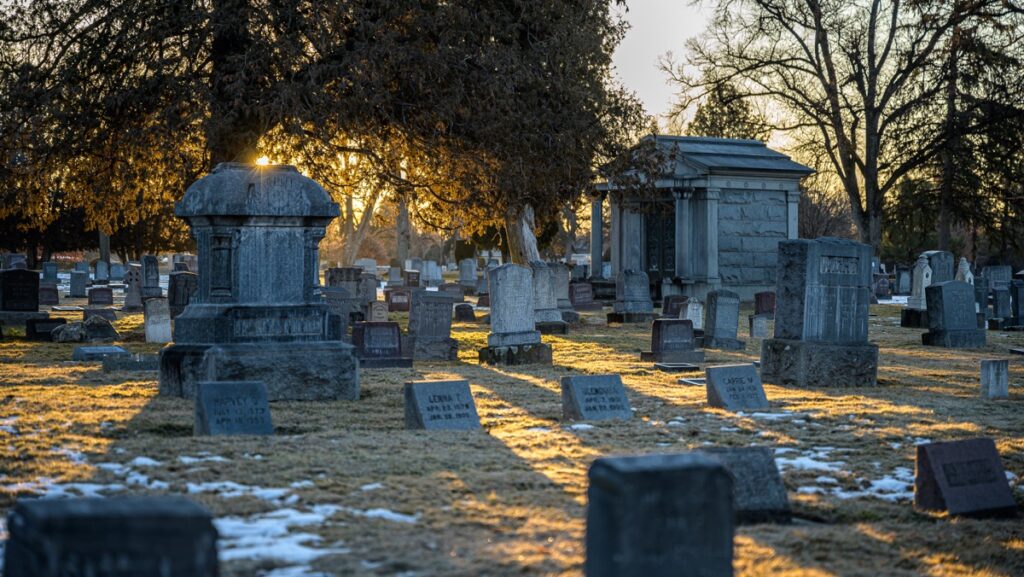There are many things to consider when planning a funeral. However, one of the most crucial decisions is the final disposition choice, which is the process by which a body is handled after a funeral. There are two options offered at most funeral homes – burial and cremation. And there are subtle nuances to these options, such as aquamation and green burial. Learn more about the different final disposition processes and their costs below.
What is cremation?
Cremation is a practice in which a dead body is exposed to extreme heat or chemical reactions that reduce organic matter into bone fragments. The bone fragments are pulverized to create a powder called “cremated remains” or “ashes.” The remains are placed in an urn or container and returned to the family. The ashes can be kept in the home, scattered, buried, or interred in a niche or columbarium (a structure that stores and displays urns). It is seen as a more cost-effective final disposition option when compared to burials.
There are two main types of cremation – flame cremation and aquamation. The processes are discussed below.
What is flame cremation?
Flame cremation is a process that uses flames and extreme heat to reduce a human body to ashes.
The flame cremation process consists of several stages that take three to five hours. The length of time varies based on the size and weight of the body and the type of casket or container used.
Before cremation takes place, the body is prepared. Anything that is not meant to be destroyed (e.g., jewelry) or poses a risk to the crematorium staff is removed. This includes artificial or non-organic implants and devices within the body that contains a battery, as they can explode in the cremation chamber. Radioactive implants, such as those used for cancer treatments, must also be removed.
Afterward, the body is kept in the casket or put in a container and placed in the cremation chamber. The container is exposed to temperatures from 760 to 980 Celsius (1400 to 1796 F). Organic matter is consumed by the heat, leaving behind bone fragments and non-combustible materials (e.g., metal fillings).
The cremated remains are removed from the chamber. After a cooling period, metal or orthopedic implants are separated from the ashes and recycled. Remaining bone fragments are mechanically processed into a coarse grey or brown powder and placed in a temporary container or cremation urn provided by the family.
What is aquamation?
Aquamation is a water-based process that uses the chemical process of alkaline hydrolysis. The body is exposed to water, heat, pressure, and alkali. This creates a reaction that speeds up decomposition and reduces the body into bone fragments.
The process begins like flame cremation with hydrolysis facility staff preparing the body. However, unlike flame cremation, implants do not need to be removed for aquamation, as they do not get destroyed, and the contents are not subject to extreme heat levels. Facility staff will also remove clothing unless it is protein-based as it is not destroyed during the process.
The alkaline hydrolysis process starts with the placement of a body in a stainless steel vessel. Next, the vessel is filled with water and potassium hydroxide (alkali). The quantity of alkali used depends on body characteristics such as weight and gender, but the ratio for the solution is approximately 95 per cent water and five percent alkali.
The vessel’s contents are exposed to high temperatures (200 to 320 F / 93 to 160 C) and agitation to prevent boiling and help break down organic material. During the process, compounds in the body are reduced to basic organic components and dissolved into the water.
Remaining after this process are bone fragments and a green-brown liquid. The liquid is released from the vessel as wastewater, and the remains and equipment are rinsed with fresh water. Finally, the bone fragments get processed into a fine, white or tan powder, placed in an urn, and returned to the family.
The scientific name for the process is alkaline hydrolysis but is also called aquamation, water cremation, green cremation, liquid cremation, flameless cremation, resomation, and chemical cremation.
Unlike flame cremation, the process does not burn fossil fuels or produce direct emissions of harmful greenhouse gases and uses less energy.
What is direct cremation?
Direct cremation involves the body being cremated shortly after death. As a result, additional funeral services and preservation techniques are reduced or eliminated.
What is the cost of cremation?
The cremation cost depends on the type chosen, but the difference is not drastic. Flame cremation is typically cheaper, ranging from $800 to over $3,000. Aquamation typically ranges from $2,000 to $3,000. Direct cremation can further reduce costs and falls within $1,000 to $3,000.
Adding to the cost are funeral services outside of the basic cremation process. Like burials, those choosing cremation can hold services such as a viewing or visitation beforehand. The more services added, will increase the cost substantially.
There are also cremation-related costs that can increase the price. For example, the cremation process costs around $500 to $700, but an urn can cost anywhere from $10 to over $2,000.
Choosing to bury or inter in a cemetery or mausoleum will also increase the price. Internment in a niche or columbarium ranges from $700 to over $2,500. A burial plot in a cemetery costs $200 to over $3,000. However, these plots can be shared, which will reduce the price. Nonetheless, cremation is traditionally more cost-effective than burials.
What is burial?
Burials are one of the most widely chosen funeral practices. Funeral burials involve a dead body being placed in the ground, covered with soil and left to decompose over time. The body can be placed directly in the soil, in a casket or coffin, or wrapped in a shroud.
People are frequently buried in a cemetery, but it can also occur in a private family plot, at sea, a green burial site, etc. Burials can also refer to internment in a public or private mausoleum – a large above-ground structure that stores the remains of multiple individuals.
What is green burial?
A green burial is a term used to describe funeral practices that minimize environmental impact. A burial following these practices involves burying a body in a way that allows it to decompose and incorporate into the soil more naturally. This means that chemical preservation techniques, such as embalming, cannot be used. The body must also be buried directly into the ground or in biodegradable caskets or shrouds. Moreover, the green burial site must promote ecological restoration and conservation.
What is direct burial?
A direct burial involves a body being buried shortly after death, eliminating additional services (e.g., visitation) and the need for embalming.
Cost of a burial
Burials are typically a more expensive funeral service. This is because burials include additional funeral services, such as visitation, viewing, wake, committal, etc. These services extend the time between death and burial, so preservation techniques are needed, increasing the price. For example, embalming costs range from $100 to $1,000.
Additionally, caskets are an additional fee, costing anywhere from $900 to $20,000, and burial plots in a cemetery cost around $200 and $3,000. With all these costs in mind, traditional burials will cost between $3,000 to $12,000.
A great way to reduce this cost is by having a direct burial. Expensive services are limited, causing the price to be lower. Green burials have a similar effect, costing around $3,000 to $5,000.

